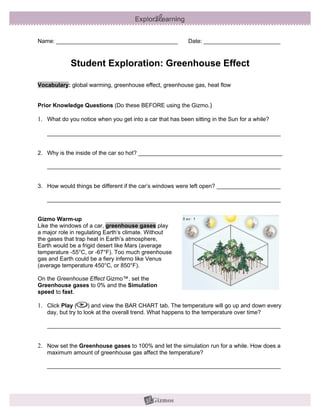
Greenhouse Gizmo
- 1. Name: ______________________________________ Date: ________________________ Student Exploration: Greenhouse Effect Vocabulary: global warming, greenhouse effect, greenhouse gas, heat flow Prior Knowledge Questions (Do these BEFORE using the Gizmo.) 1. What do you notice when you get into a car that has been sitting in the Sun for a while? _________________________________________________________________________ 2. Why is the inside of the car so hot? _____________________________________________ _________________________________________________________________________ 3. How would things be different if the car’s windows were left open? ____________________ _________________________________________________________________________ Gizmo Warm-up Like the windows of a car, greenhouse gases play a major role in regulating Earth’s climate. Without the gases that trap heat in Earth’s atmosphere, Earth would be a frigid desert like Mars (average temperature -55°C, or -67°F). Too much greenhouse gas and Earth could be a fiery inferno like Venus (average temperature 450°C, or 850°F). On the Greenhouse Effect Gizmo™, set the Greenhouse gases to 0% and the Simulation speed to fast. 1. Click Play ( ) and view the BAR CHART tab. The temperature will go up and down every day, but try to look at the overall trend. What happens to the temperature over time? _________________________________________________________________________ 2. Now set the Greenhouse gases to 100% and let the simulation run for a while. How does a maximum amount of greenhouse gas affect the temperature? _________________________________________________________________________
- 2. Get the Gizmo ready: Activity: • Click Reset ( ). Heat in, heat out • Set Simulation speed to slow. • Be sure the Greenhouse gases level is 10%. Question: How do greenhouse gases affect Earth’s climate? 1. Observe: Select the BAR CHART tab and click Play. After about 24 simulated hours, click Pause ( ). What do you notice about the Heat flow into and out of Earth’s atmosphere? _________________________________________________________________________ _________________________________________________________________________ 2. Analyze: Select the TABLE tab. A. At what time of day is heat flow into the atmosphere (Hin) greatest? ______________ B. At what time of day is heat flow into the atmosphere (Hin) least? ________________ C. Does heat flow out of the atmosphere (Hout) change during a day? ______________ D. At what time of day is surface temperature highest? _________ Lowest? _________ 3. Predict: Click Reset. When you change the amounts of greenhouse gases in the atmosphere, which factor(s) do you expect to change? (Circle your answer/answers.) Heat flow in Heat flow out Temperature 4. Experiment: Select the BAR CHART tab, and click Play. While the simulation is playing, move the Greenhouse gases slider back and forth. What do you notice? _________________________________________________________________________ _________________________________________________________________________ 5. Experiment: Click Play, and this time observe the GRAPH tab as you change the Greenhouse gases. What do you notice? _________________________________________________________________________ _________________________________________________________________________
- 3. (Activity continued on next page)
- 4. Activity (continued from previous page) 6. Draw conclusions: The influence of greenhouse gases on temperature is called the greenhouse effect. Based on what you have seen, how do greenhouse gases affect the heat flow into and out of Earth’s atmosphere? _________________________________________________________________________ _________________________________________________________________________ _________________________________________________________________________ _________________________________________________________________________ 7. Extend your thinking: Atmospheric concentrations of greenhouse gases such as carbon dioxide have risen dramatically in the past century. Most scientists agree that this has begun to result in global warming, a slow increase in average temperature worldwide. What are the possible consequences of global warming? _________________________________________________________________________ _________________________________________________________________________ _________________________________________________________________________ _________________________________________________________________________ _________________________________________________________________________ _________________________________________________________________________ _________________________________________________________________________ Note: The reason greenhouse gases raise the temperature of Earth’s atmosphere is similar to, but not identical to, the way that the glass in a greenhouse raises the temperature inside. In a greenhouse, sunlight passes through the transparent glass and is absorbed by the plants and soil below. Heat is then radiated from plants and soil, which heats the air inside the greenhouse. The hot air is trapped by the glass. If the glass were not there, the hot air would mix with the colder air outside, and the result would be similar temperatures inside and outside the greenhouse. In Earth’s atmosphere, greenhouse gases are transparent to visible light but absorb heat that is emitted from Earth’s surface. Some of this heat is then reflected back to Earth. If the greenhouse gases were not present, all of the heat would radiate into space instead. Don’ t forget to do the assessment questions below the Gizmo!